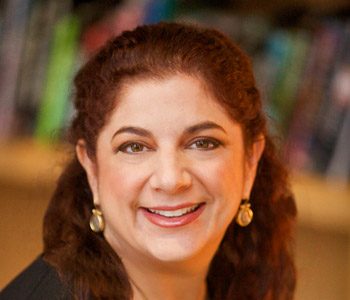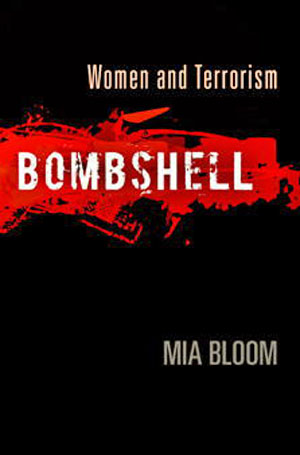
In my book Bombshell: Women and TerrorismI examine the changing nature of terrorism.
The face of terrorism is changing—and it is now often a woman’s face. No longer can we expect terrorists to look a certain way, be a certain age, or gender. In the book, I argue that women are subject to a variety of recruitment strategies. While many people assume that all women are forced by a man in their lives to engage in violence, in fact, this varies greatly from organization to organization. Some groups experienced the women themselves demanding to participate, for example Hamas in the 1990s. While the former leaders of Hamas, Sheikh Rantisi and Sheikh Yassin initially rejected female suicide bombers, many Palestinian women began to lobby for the right to demonstrate that they were just as dedicated as the men and wanted to become Istishhadiyya (self martyrs).
One woman, featured in the book, Ahlam al Tamimi, became a leader of Hamas’ female prisoners. Tamimi is one of over 1000 Palestinian Prisoners being released in exchange for captured Israeli soldier, Gilad Shalit. Women in the Provisional IRA were never forced to engage in violence and many Tamil women in Sri Lanka were also enthusiastic participants. Many of the former female IRA women, are also leaders in the Stormont Parliament.
However, these examples are in stark contrast to the Iraqi women in Diyala province in the Sunni triangle were not just mildly coerced or pressured, but selectively targeted women to be raped in order to give them no other option but to become bombers for Ansar al Sunnah.
I think the extent to which an organization will coerce women is important to emphasize because it says a lot about how much the group cares about its population but also how strong or weak they are.
It is also significant that one of the major rallying cries to engage in the Jihad in Iraq or Afghanistan by groups affiliated with Al Qaida has been to protect the “sisters in Islam” from attack, when in fact, in many instances, it is the groups themselves that attack the women’s honor. I suspect that many readers would be appalled to know about the activities of Samira Ahmed Jassim who organized the rape of 80 women for this purpose.
Using women is an excellent way to shame men into participating. I think in certain societies the use of women will help also recruit men to the cause because of the feeling that women are doing their work. This has been debated in some of the Jihadi circles about whether a woman’s obligation for Jihad is equal to that of a man. I think it is also conveys the idea that the conflict is unstoppable if even the women are involved.
Finally, as I was completing the book, Umayma al Zawihiri came out with a open letter to all women stating that women could in fact participate in Jihad and even as suicide bombers all the while her husband, Ayman al Zawahiri was categorically saying that there were no women in Al Qaida. I think this is a way for Zawahiri (before the death of Osama Bin Laden) to play both sides of the debate.
Significantly, since Mrs. Zawahiri’s letter, a number of websites and publications have emerged that encourage more Jihadi women to take an activist role. And certainly, we see that among the new generation of leaders, people like Omar Hammami have a more “progressive” attitude about women suicide bombers and militant activists.
Not only will we likely see more women in places like Somalia, Uzbekistan, Pakistan and Iraq, and even places like Afghanistan and the Gulf, but we are likely to see also more and more children being used as bombers.
No one is expecting traditional women. Finally, the traditional clothes, like the Niqab allows one to hide an improvised explosive device effectively and if anything, might give the impression of a late term pregnant woman, which is also an excellent disguise.
The book relates to the changing nature of terrorism and how different groups are either being forced or recruited into these deadly organizations.
I address several underlying theories about the nature of political violence and how organizations mobilize and recruit populations to become involved.
The first section takes into an actual suicide bomb attack by a woman in Moscow in March of 2010. I intended to provide the reader with what it feels like to be on the scene, including the sights and sounds. But the whole book provides details never before published about the women who engage in terrorism, why they did it, and how being involved in terrorism changed their lives.
Although people might assume that women’s participation in terrorism or in any form of political violence might help level the society in terms of the equality between men and women, the reality is not the case.
Only in cases in which women are not just cannon fodder as bombers but also participate as leaders and ideologues that women’s involvement helps the status of women in the society as a whole.
In places like Europe, women’s participation in terrorism has led to a variety of women leaders. A good example is Ulrike Meinhof who led the Red Army Faction in Germany or members of the Provisional IRA in Northern Ireland. Many of the women in Ireland now hold seats in Stormont, the Northern Irish Parliament.
However, if the best and the brightest women of the society become suicide bombers, this will actually eliminate the next generation of female leaders.
In essence, my book conveys the message that women who want to do something for their people or their society need to find other ways to do so. Women need to know that they can make more of a difference with their lives than with their deaths. That is one of the underlying messages in my work and I hope that in writing a book about women’s involvement, to shed some light on the phenomenon.
The final point that I make in the book is with regard to what we can expect next. I think that as more and more targets are hardened and made difficult for terrorists to access, they will switch tactics and use children. We have already seen the emergence of Islamic Schools in Pakistan training very young children to become suicide bombers before the age of 14. We will see more children enter the fray and sadly, this will have devastating consequences on their societies but also on forces that have to face children.


Mia Mellissa Bloom is an Associate professor in International and Women’s Studies at the Pennsylvania State University and a fellow at the International Center for the Study of Terrorism. She is the author of Dying to Kill: The Allure of Suicide Terror, Living Together After Ethnic Killing with Roy Licklider, and Bombshell: Women and Terrorism. Bloom is a former term member of the Council on Foreign Relations and has held research or teaching appointments at Princeton, Cornell, Harvard, and McGill Universities. She has a Ph.D. in political science from Columbia University, a Masters in Arab Studies from Georgetown University and a Bachelors from McGill University in Russian and Middle East Studies and speaks nine languages.